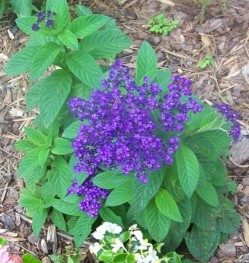|
Gardens Ablaze |
||
|
|
Heliotrope |
|
|
Detailed Annual Site Map
Home
|
The word "Heliotrope" means to turn toward the sun, and predictably, the flower heads on these plants move with the sun as it crosses the sky, though in my opinion, this is really not very noticeable due to the large flower heads. Heliotrope can be found with flowers in blue, purple, and white, with purple being the most fragrant and most available. One thing that I have admired about this plant in my own garden (after the fragrance, of course), is the beautiful dark green, deep veined, almost velvety foliage. This plant sports some of the best-looking foliage on any ornamental I have come across lately. Like most annuals, Heliotrope is actually a tender perennial, but it will only survive winters in the warmest climates. Good thing then, that it roots readily from stem cuttings, with the cutting producing flowers within six weeks or so. Therefore, just pot up a cutting or two a few inches long and take it indoors to a sunny window for the winter, transplant back to the garden after all danger of frost, and you will always have this lovely plant in your garden during the mild months. Heliotrope appreciates moist, but not wet conditions and full or near full sun. If the soil dries out too much, the lower leaves will turn black and fall off, compromising the overall look of the plant. Therefore, in my experience, this plant does best in a bed covered with a few inches of good mulch to keep the roots cool and evenly moist. Because this is a known problem that is probably going to happen to you, I recommend that you also plant lower-growing ornamentals at the feet of the Heliotrope. Orange Marigolds look nice next to purple Heliotrope, or maybe pink Verbena, or pink or white begonia, to name a few. Fertilize every 6 weeks or so with a slow-release balanced fertilizer such as 10-10-10. I simply scatter fertilizer granules periodically throughout the entire garden, with good results. Deadhead flowers so the plant will continue producing blooms. Leave blooms on the plant to dry for collecting seed, and when completely dry, shake into some sort of container such as a bowl, and then hand separate the seed from the chaff. Seed takes a long time to germinate (a month or more), so cuttings are the preferred propagation method for this plant. Heliotrope grows to about 2 feet, occasionally a little more, and makes a wonderful addition to mixed plantings, fragrance gardens, or container gardens. Try it in a hanging basket at nose level to really appreciate the scent, or plant a big pot with several plants and place on a deck or patio to enjoy the fragrance in the evening after a long day. This plant is all about fragrance, fragrance, fragrance, and we could all use a little aromatherapy in our lives, so next spring when you go to the nursery, keep an eye out for this really nice plant!
Custom Search
|
|
|
Gardens Ablaze |
||
 Heliotrope,
or Cherry Pie Plant is a delightful old-fashioned addition to the home garden
that everyone should seek out and try. The fragrance of this plant is an
intoxicating vanilla-cinnamon-fruit scent that is most noticeable in the
morning and early evening.
Heliotrope,
or Cherry Pie Plant is a delightful old-fashioned addition to the home garden
that everyone should seek out and try. The fragrance of this plant is an
intoxicating vanilla-cinnamon-fruit scent that is most noticeable in the
morning and early evening.